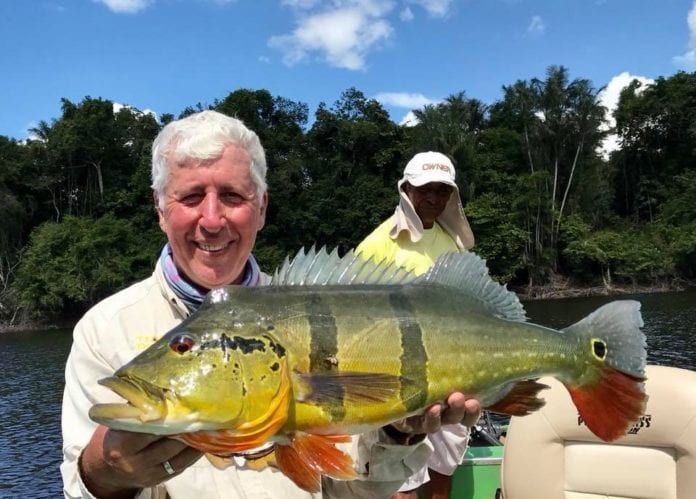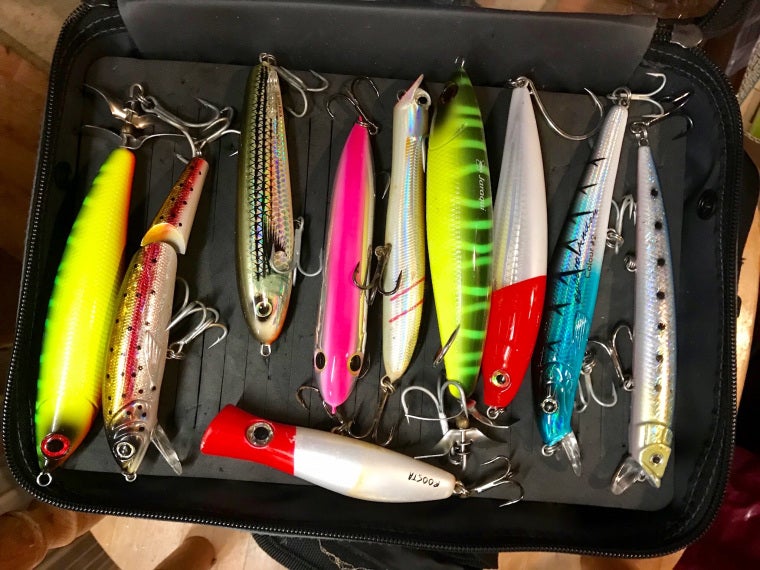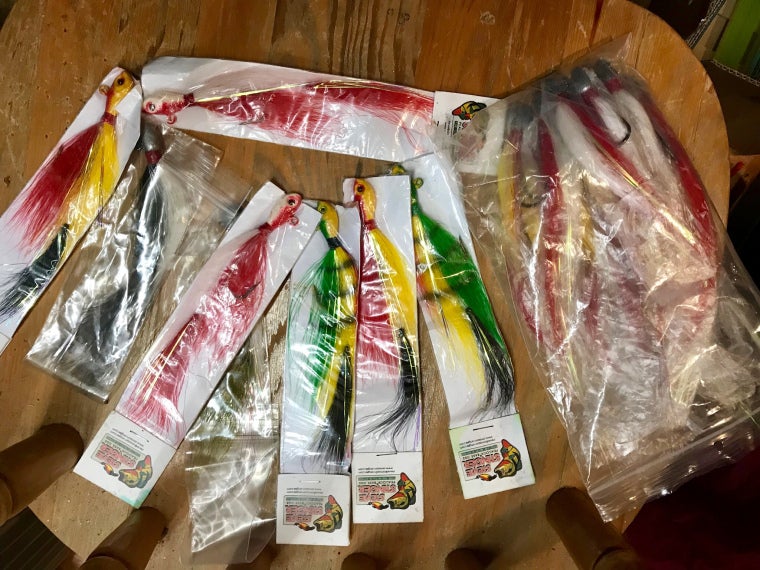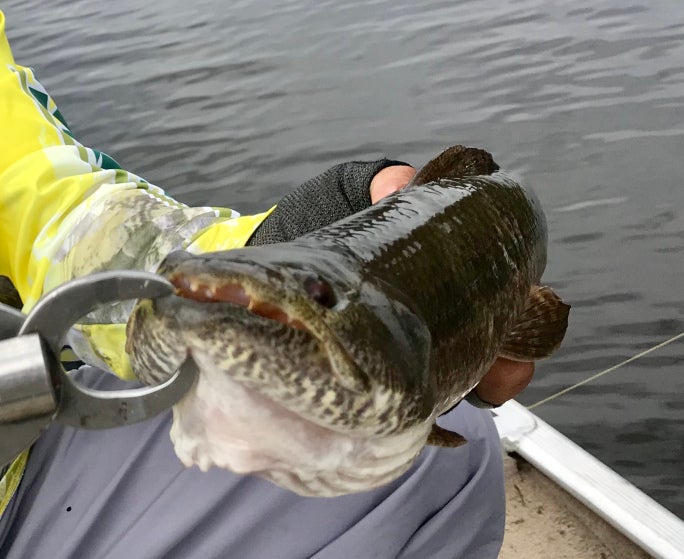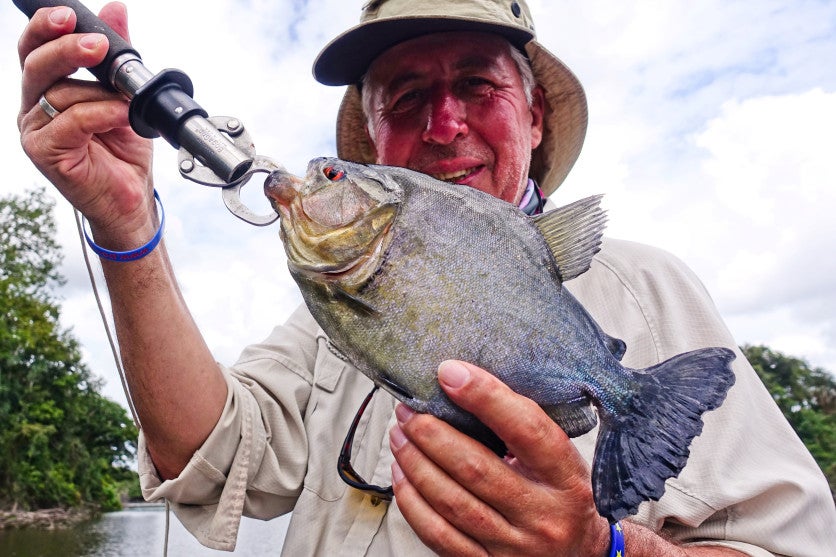With the country on lockdown thanks to COVID-19 the options for us getting our fishing fix are now reduced to books, magazines and the internet. Whilst it’s nowhere near the same as actually being there I’ve enjoyed reliving some of my more memorable fishing adventures to far-flung destinations. I hope you find this one interesting…
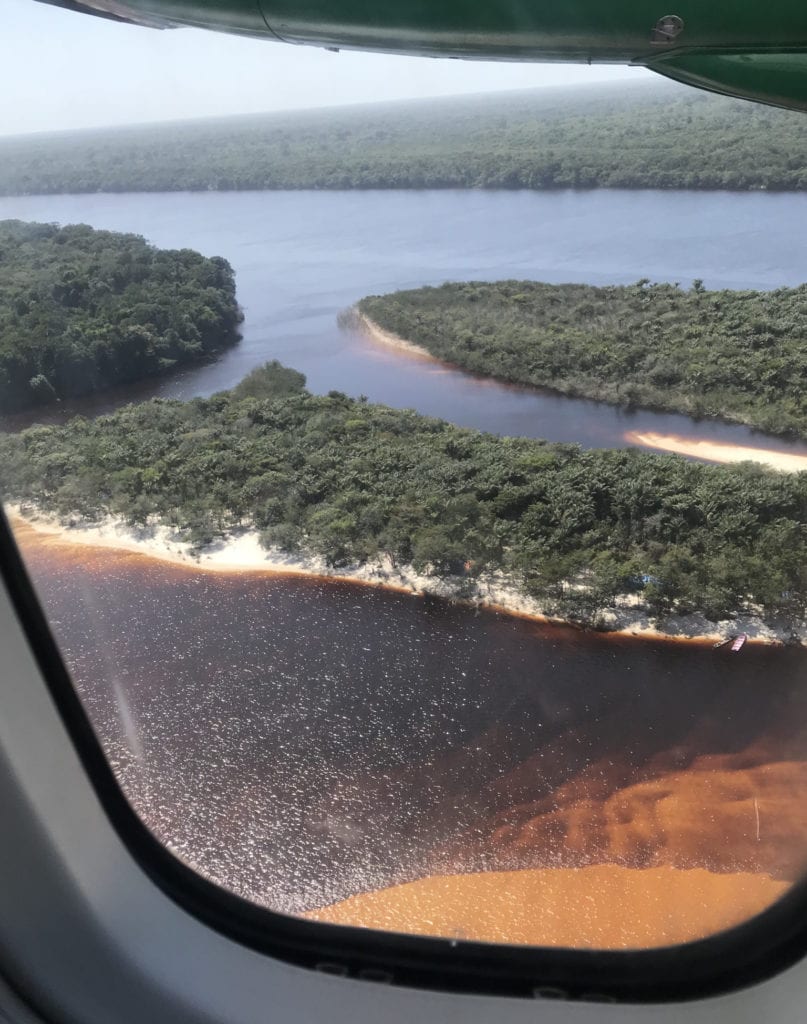

Peacocks on the Amazon
I guess most well-travelled anglers could construct a list of great rivers they have fished, and those that want to, before they are called to make that last, fateful cast. For me I would have to include England’s finest – the Thames, Severn and Wye; the sparkling Scottish salmon rivers Spey and Tay; the long and fish-filled Shannon in Ireland and the powerful Fraser River that drains the Canadian Rockies. There was a trip to the massive Murray Darling system in Australia where I failed to catch a Murray Cod and all manner of rivers, creeks and estuaries in the Northern Territory where the barramundi were much more obliging.
My future wish list still contains the Nile and the Zambezi in Africa where I hope to make the acquaintance of giant perch and ferocious tiger fish. But all of these magnificent waterbodies are as nothing compared to the place I visited in 2018 for the first, and certainly not the last, time. Believe me, you’ve not seen a truly big river until you’ve been to the Amazon.
A staggering 20% of all the freshwater on the planet that enters the ocean discharges from the 320 kms wide mouth of the Amazon. This really is the daddy of all river systems holding over 2000 different species of fish ranging from the giant ten-foot long air-breathing Arapaima and river catfish weighing up to 600-700 lbs, to tiny tetras and fresh-water flying-fish. I defy any serious angler not to be awe struck by their first sight of the Amazon as emerges from its own giant rainforest and bisecting an entire continent. You really have to see and fish this place – and here’s why…
The Place
Manaus is where it all begins. A vibrant city of over two million people that even boasts its own Opera House – surely a rainforest first – which is a throwback to the days of the rubber barons who made enormous wealth from exploiting the region’s resources. The city is situated a few kilometres upstream of the junction of two massive river systems. From Peru to the west comes the Amazon Solimões which is joined from the north by the darker waters of the Rio Negro – the place that was to be our home for the next six days. The Rio Negro and its tributaries and lagoons hold some of the largest peacock to be found in the Amazon. It is a ‘blackwater’ river that runs the colour of weak Coca Cola caused by a tannin stain that enters the water as it drains through the rain forest foliage. And best of all it carries a level of acidity that makes it impossible for mosquitoes to breed. Imagine fishing six days in a tropical rainforest and no insect bites!
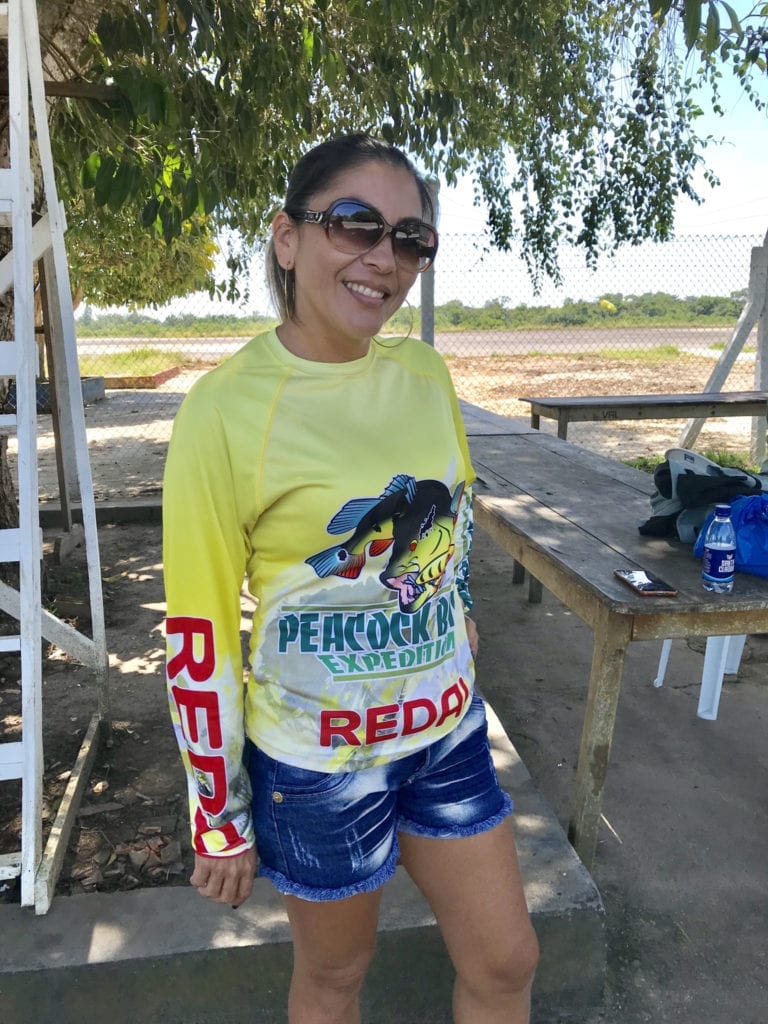

The People
Myself and my traveling companions, Keith Elliott and Mark Edwards from the UK, were met at the airport by Steve Townson – the man who probably knows more about fishing this incredible region than anyone else outside of Brazil. Steve runs Amazon Angler and has been organising trips to the rivers of South America for nearly 20 years. He was twice World Champion peacock bass angler and is a fluent Portuguese speaker with an unparalleled network of contacts right across the continent.
After 17 hours in the air it was a tired but grateful group of Brits that were driven through the anarchic traffic to downtown Manaus and our hotel. Very quickly we realised that we had arrived at Peacock Bass Central as the lobby was heaving with rod tubes, cases and rucksacks from all over the world. Saturday was clearly changeover day and tanned and tired anglers were checking out alongside expectant new arrivals with clean bags and lighter skins. Americans were the largest group by far. Hardly surprising since the popularity of peacock bass fishing has seen a direct six hour flight established from Miami to Manaus.
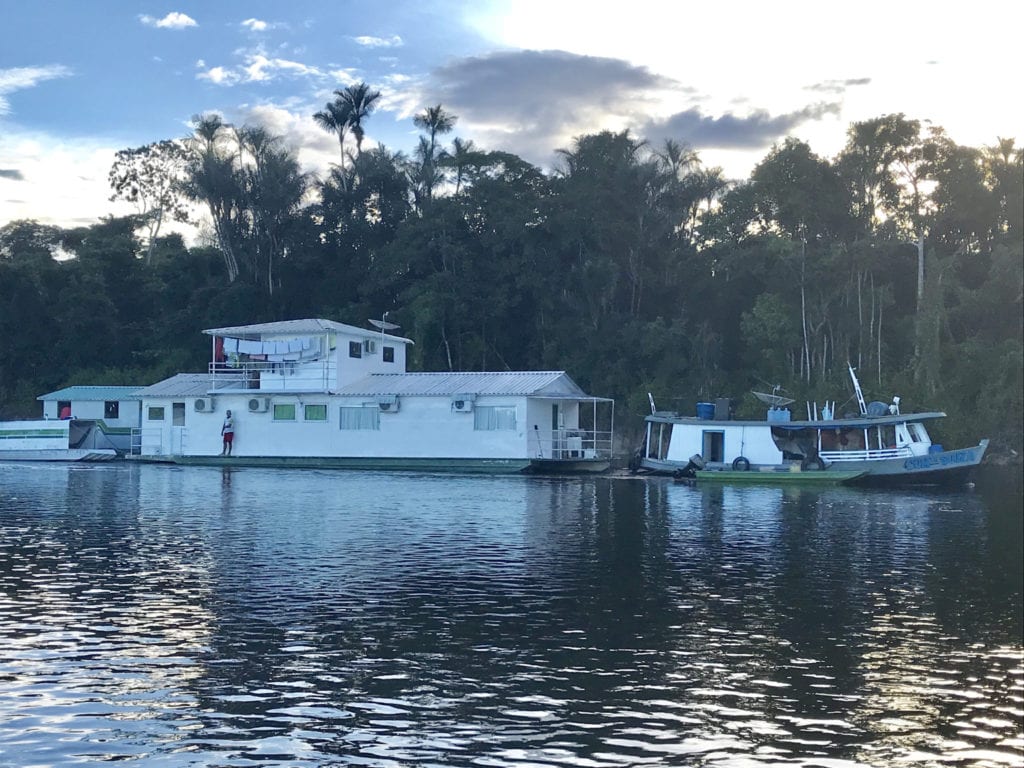

The Floating Camp
With watershed as changeable as the Amazon mobility is everything and Steve and his partner Marlon wanted more flexibility and so built the first floating fishing camp. With an incredibly shallow draft the Cabaçeiras Floating Pontoon Camp can be on the move at a minute’s notice, through even the hardest-to-reach and far-flung areas of the Amazon. It was launched in 2013 and is towed along by a small support boat equipped with a satellite phone to guide in the light floatplanes that take visiting anglers to and from wherever it is moored.
The camp has six double bedrooms with en-suite bathrooms, a good-sized dining room and lounge area, a kitchen and a bar. A separate diesel generator is towed behind on its on barge and behind that comes the fleet of six, bass sportfishing boats with electric trolling motors and spacious casting decks. Now I’m well used to roughing it on these trips but not this time. Despite being hundreds of miles from human habitation we had wonderful food, ice cold beers and comfortable air- conditioned rooms as every bit as good as could be found in an expensive fishing lodge.
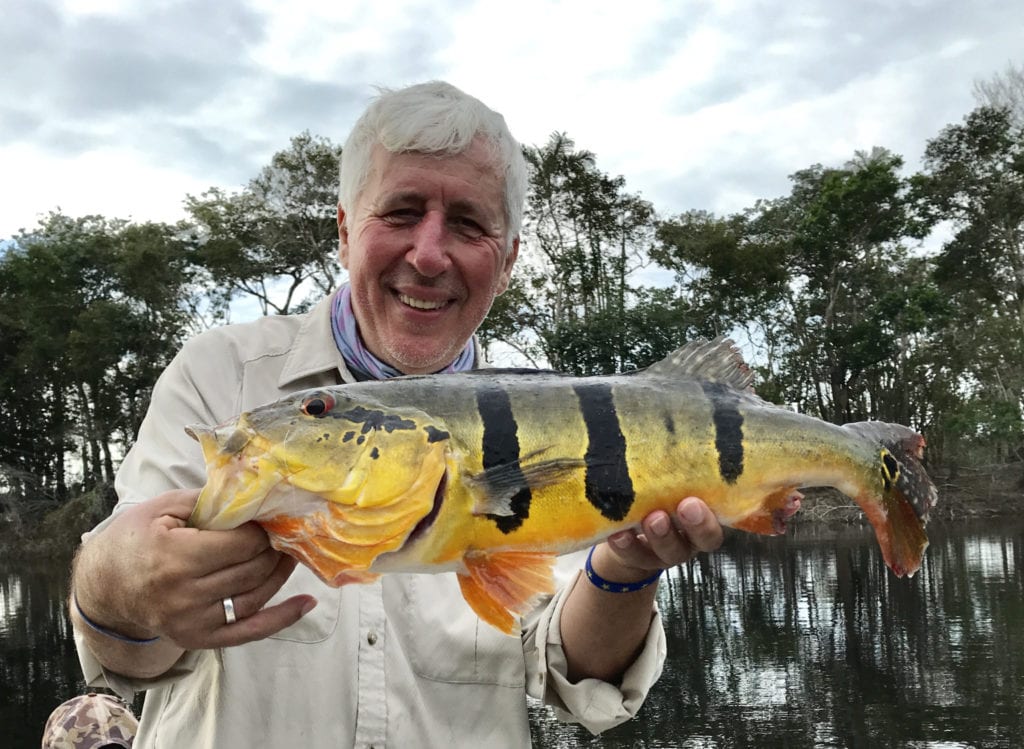

The Fish
And so, after two days of travel, it was finally time to get fishing. Peacocks are like a cross between a barramundi and a giant perch with the power and aggression of small tarpon. They hit surface and sub-surface lures with a brutal force, often engulfing the bait in an explosive, heart stopping take the like of which is seldom to be found in freshwater. The world record is 29lbs and any fish over 15lbs is considered a real specimen, although most anglers would be delighted to land a few double figure fish over the course of a trip. There are three main types of peacock bass: the speckled, the three bar and the smaller, but extremely pretty butterfly variety. As spawning approaches the bass change their behaviour creating ‘nests’ for their offspring which are guarded ferociously. The males develop a distinct bump on their foreheads and as the speckled peacocks or ‘pacu’ grow larger they mature into the three bar versions gaining the local name ‘acu ’.
The Fishing
With 11 anglers and six boats and guides at our disposal there was scope for some of us to swap about. So the four Brits – Keith, Mark, Roger and myself teamed up and decided that we would all fish together in pairs over the course of the week.
The plan was to move camp every day eventually ending up on one of the smaller tributaries but we began our fishing on the main stem of the Rio Negro searching out the backwaters and the flooded oxbow lakes and lagoons that were still connected to the river. Although the other guys did somewhat better, with a number of decent fish landed, my first day was quiet with only seven peacocks to the boat and none of them over four pounds. Day Two and everything changed as we entered an almost prehistoric lagoon. Casting big prop baits as close to the snags as we dared soon stirred things up. If the peacocks didn’t always smash the giant cigar shaped fizzers they were certainly fired up by the noise and action. Steve had told us to bring prop baits, spooks, shallow divers and minnows but to expect to catch 70% of our fish on jigs. Ever prepared to listen to the voice of experience we had all packed a good supply of 1/2oz and 5/8oz brightly coloured bucktail jigs with extra-strong 4/0 and 5/0 Eagle Claw hooks. Casting into the wake of Roger’s prop bait secured me several savage takes as the fish turned away from the bigger lure and nailed the jig. At the end of the day Roger and I had boated 27 peacocks up to eight pounds, lost a good few besides and encountered a number of other species. We felt as though we were getting the hang of things and, after a good meal and an appropriate amount of rum, we went to bed tired but happy.
Everything about this Amazonian fishing is supercharged. It’s as if all the flora, fauna and fish have been dosed with steroids. The rainforest is massive and impenetrable, and some rivers can rise over 20 metres in the wet season creating perfect habitat for an incredible variety of fish species including Amazon river dolphins the size of of a trailer boat. The river otters are huge, more like small cows, and everything eats everything else. It is predator city and there’s no room for dainty tackle or subtle presentation. No gentle bottom bouncing or sink and draw retrieves. Out here you wind your jigs in hard and you work the prop baits with an exaggerated sweeping motion to create maximum surface displacement. And when the takes come there is no mistaking them. Several times I felt that I was close to having the rod dragged from my grip and on one memorable occasion I had a 80lbs clip opened up on the strike.
The tackle needs to be robust. My spin outfit was loaded with 30lbs braid and the baitcaster with 40lbs. The fluorocarbon leaders were ten pounds heavier to withstand the the abrasion as the fish tried to tie us back into the tree roots from whence they had emerged to engulf our lures. Inevitably the piranhas were sometimes a pain, nipping off the ends of our jigs and at five dollars a pop this was not something to be tolerated for long. Luckily a switch to a similarly sized hard bodied minnow kept the fish coming and the wallet safe, even if it did mean having to carefully unhook a few larger piranha.
My next two days were spent in the company of my good friend Keith. By now our camp had left the main river and we were heading slowly up the Rio Demini. And the further we travelled the better the fishing seemed to get. The Demini at this point varied in width from 150 to 200 metres with shallow sandbars on the inside of the bends to deep swirling eddies and pools where an obstruction had caused the current to scour out perfect lies for the red tailed catfish that Keith was so keen to catch. Now I’m not all that fussed about catfish in general, considering them to be too ugly to want to get closely acquainted. However, as a concession to Keith I agreed to devote a couple of hours each day to sitting in the shade of a big tree, upstream from a likely catfish lair, ledgering a chunk of freshly killed fish behind a four ounce sinker. With no action forthcoming I got quickly bored with this game but amused myself catching all manner of exotic baitfish from under the boat using a long shanked hook to avoid getting bitten off by the inevitable piranhas.
Red Letter Finale
When these far flung fishing trips go to plan they invariably include a red letter day for most of the group. When this occurs early on it can make the rest of the holiday a bit of an anticlimax but this was certainly not the case for us on the Amazon.
Our pontoon camp often traveled through the night far up into the headwaters of the Demini. Apart from a few ‘Ribeirinhos’ who lived on boats making a living trapping the smaller species for the tropical fish market, we were all alone with the wildlife. Every mile or so there was another lagoon entrance to be found and with the fast receding water levels we sometimes had to get out and push the boats over the sandbars that guarded the entrances to these incredibly fishy locations.
The last day in particular will stay with me forever. I was with my friend Mark, probably the best lure angler in our party, and our guide, Andros, promised us a day of two halves. In the morning he navigated us through the seemingly impenetrable entrance to quite a narrow lagoon which tapered and shallowed as we went in further. Were told this was the place for numbers rather than quality so Mark and I had great fun using our lighter spin outfits and working little ‘walk the dog’ spooks across the surface to entice almost constant action. Long casting onto the sandy margins under the trees and then plopping the lures back into the water produced some instant and spectacular takes and not just from all three varieties of peacocks. I think that morning I had over 20 traira or ‘wolffish’, a solitary rare and brightly coloured jacunda and about 20 bass to nine pounds. Mark had a similar amount and double hook ups became the norm rather than the exception.
After lunch in a shady mooring spot Andros took us to a place where he reckoned we could catch something a bit special and he wasn’t wrong. This lagoon was much wider and deeper and I doubt if it had been fished at all that year. The stronger bait caster rigs were selected and we began working our prop baits and jigs along the heavily wooded margins. The action was at times nothing short of brutal. Big double figure peacocks would come charging out of the snags, often competing to be first to the lure. As we got further along one particularly margin huge explosions could be heard as the peacocks herded the unfortunate bait fish into the zone before launching themselves at their prey. At times it sounded as if someone had dropped a pig into the water from the top of a tree.
Needless to say we spent a lot of time enjoying this carnage and it was no surprise when Mark landed the biggest fish of the the trip – a gorgeous 18lbs three barred specimen that contested every inch of the way to the boat. We ended the day with over 80 bass between us and both lost fish that may have been bigger. But it was so hard to tell. These things pull like no other freshwater species that I have ever come across which is why we are already planning a return trip.
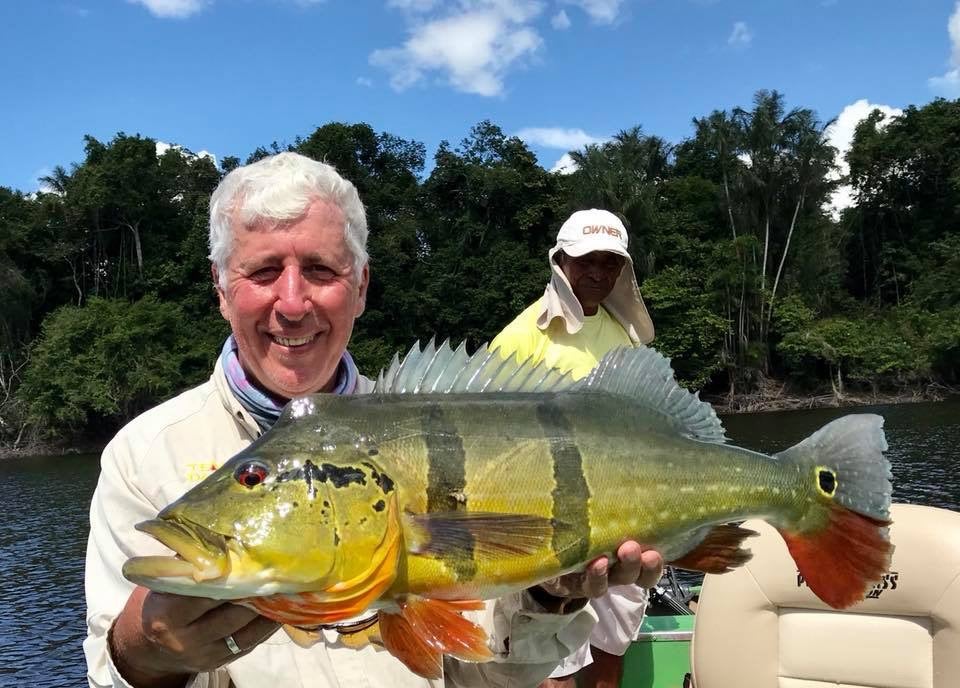

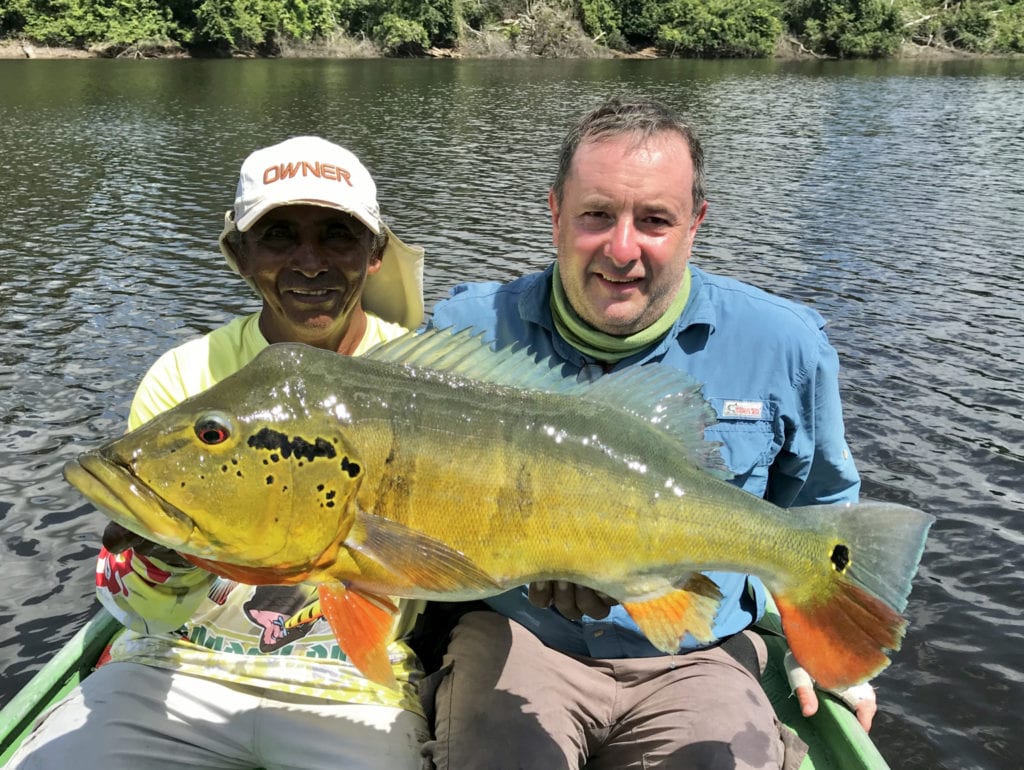

I’ve been lucky enough to fish some pretty special places on this fast diminishing planet of ours. The Amazon basin is like no other and if it’s high octane freshwater lure action that you seek then my advice is to get out there and give it go. Trust me, it’s worth the effort, but be warned – you’ll want to come back for more!
Amazon Fact File
Amazon Angler: http://www.amazon-angler.com/home/4585618432
Trip info: https://view.publitas.com/p222-9486/cabaceiras-floating-pontoon-brazil
Video link for this trip: https://www.youtube.com/watch?v=KyRnyKHbVRI
Peacock bass info: http://www.amazon-angler.com/peacock-bass/4577908495
Martin’s blog is reproduced with the kind permission of the Angling Trust. Further editions can be found here: https://fightingforfishing.anglingtrust.net/










